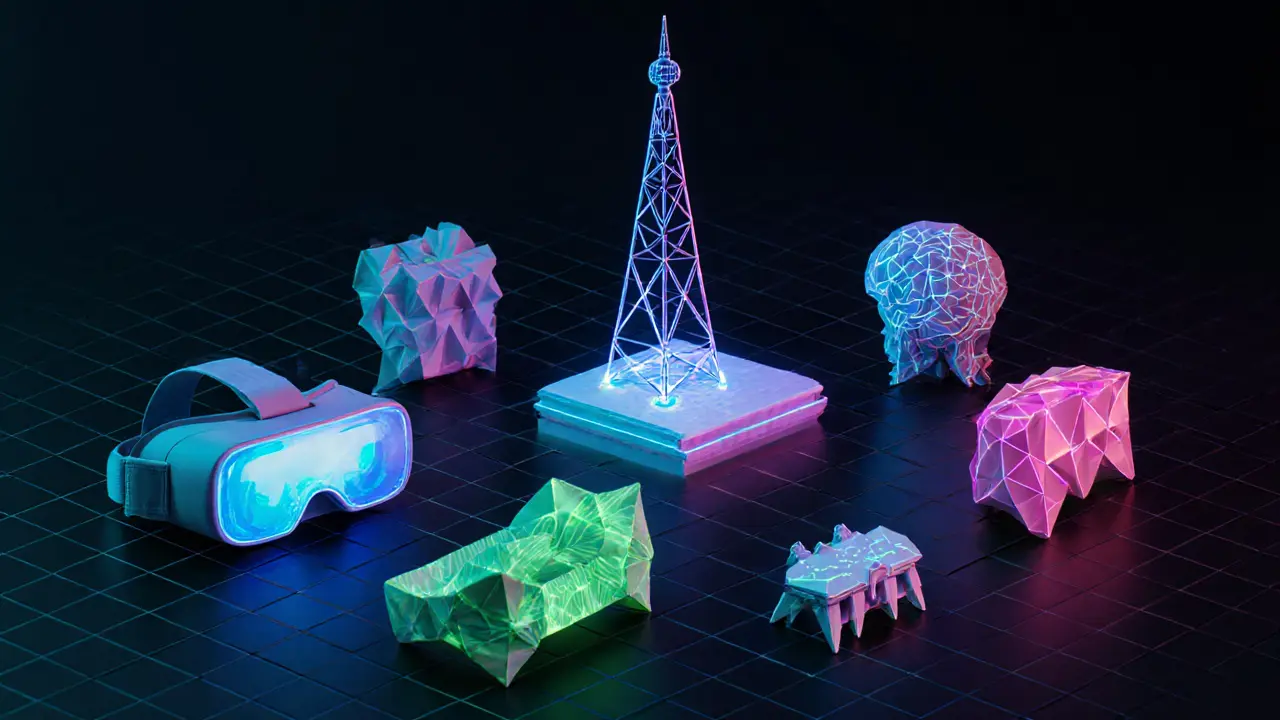Metaverse ROI Calculator
Calculate Your Metaverse ROI
Estimate your return on investment based on industry data showing companies see ROI within 12-18 months with proper implementation.
Key Takeaways
- The metaverse will shift from novelty to industry‑specific platforms by 2030.
- Hardware is the biggest adoption blocker; lightweight AR glasses are slated to replace bulky VR headsets.
- Blockchain, AI, and 5G together create the backbone for secure, real‑time, personalized experiences.
- Companies that start with clear business goals and modular development teams see ROI within 12‑18 months.
- Regulatory clarity around data privacy and digital assets is expected by early 2026, boosting enterprise confidence.
What is the Metaverse?
Metaverse is a persistent, shared virtual 3D environment that blends the physical and digital worlds. Users can enter through smartphones, computers, or immersive headsets, creating a sense of presence that static web pages cannot match. Unlike a single game or social app, the metaverse aims to be interoperable, allowing avatars, assets, and data to move across multiple platforms.
Today’s metaverse is still in the construction phase. Major tech firms are laying the groundwork with cloud services, SDKs, and early‑stage marketplaces. For a user, the experience feels like stepping into a parallel internet where you can shop, learn, or attend concerts without leaving your living room.
Core Technologies Driving Today’s Metaverse
Seven pillars support the current ecosystem:
- Blockchain provides immutable records for crypto payments and NFTs, ensuring that digital ownership stays verifiable across worlds.
- Augmented Reality (AR) overlays information onto the real world, letting users see virtual objects while staying grounded in physical space.
- Virtual Reality (VR) fully immerses users by blocking the outside world, delivering the most intense sense of presence.
- Artificial Intelligence (AI) powers realistic avatars, adaptive environments, and intelligent assistants that learn from user behavior.
- 5G offers low‑latency, high‑bandwidth connections essential for real‑time interactions across millions of devices.
- Edge Computing brings processing power closer to the user, reducing lag that cloud‑only solutions struggle to meet.
- Internet of Things (IoT) links physical sensors and actuators to virtual spaces, enabling scenarios like remote equipment maintenance inside a digital twin.

What the future of metaverse Might Look Like
Analysts agree that the next five years will be defined by three converging trends: lighter hardware, smarter software, and open economies.
| Component | Current State (2025) | Future Outlook (2030) |
|---|---|---|
| AR/VR Headsets | Bulkier VR rigs costing $800‑$1500; AR glasses in early beta. | Lightweight AR glasses under $300, seamless mixed‑reality with eye‑tracking. |
| Blockchain & NFTs | Mostly experimental marketplaces; high gas fees on public chains. | Scalable Layer‑2 solutions and interoperable NFT standards enable real‑world asset tokenization. |
| AI‑Driven Avatars | Pre‑recorded animations; limited natural language understanding. | Generative AI creates lifelike expressions and context‑aware dialogue in real time. |
| 5G / Edge | Urban coverage good; rural latency still >30ms. | Ubiquitous sub‑6GHz 5G plus edge nodes bring latency under 10ms worldwide. |
| IoT Integration | Isolated sensor feeds, manual data uploads. | Digital twins update in seconds, allowing live‑sync of factories, cities, and homes. |
With these upgrades, the metaverse is expected to become a utility platform-think of it as the next operating system for digital interaction. Developers will no longer need to rebuild networking stacks; they’ll plug into standardized APIs for identity, payment, and spatial data.
Business Opportunities and Risks
Industries are already testing metaverse pilots. Retailers launch virtual storefronts where shoppers can try on 3‑D garments; universities host immersive labs that let students dismantle a virtual engine.
Key opportunities:
- New revenue streams: Sale of digital fashion, virtual real‑estate, and experiential tickets.
- Brand differentiation: Early adopters gain a tech‑savvy image that attracts younger demographics.
- Operational efficiency: Remote collaboration in a shared 3‑D space reduces travel costs and shortens design cycles.
But the upside comes with pitfalls:
- Hardware barrier: High upfront costs keep casual consumers out of the loop.
- Scalability pressure: Running a seamless world for millions requires robust edge networks and careful data architecture.
- Regulatory fog: Data‑privacy laws and crypto regulations differ by region, creating compliance headaches.
Overcoming Current Barriers
Three practical steps can mitigate most obstacles:
- Adopt a modular architecture. Build core services (identity, payment, rendering) as separate micro‑services. This lets you replace a component-say, swap a proprietary rendering engine for an open‑source alternative-without a full rebuild.
- Start with a narrow use case. Instead of a full‑blown virtual campus, pilot a “showroom” for a flagship product. Measure engagement, iterate, then expand.
- Leverage existing ecosystems. Platforms like Microsoft Mesh or Meta Horizon already supply SDKs, user authentication, and marketplace integration, cutting development time by 30‑40%.

Roadmap for Companies Wanting to Enter the Metaverse
Below is a six‑month blueprint that aligns technical milestones with business goals:
- Month1‑2: Goal definition & stakeholder alignment. Identify the problem you’re solving (e.g., virtual product demo) and set KPIs such as average session length or conversion rate.
- Month3: Prototype core experience. Use a low‑code platform to create a simple 3‑D scene, integrate basic avatar controls, and test on both VR headsets and mobile AR.
- Month4: Add blockchain layer. Mint a test NFT for each digital asset, set up a wallet integration, and ensure transaction data logs to a private ledger.
- Month5: Optimize performance. Move compute‑intensive tasks (physics, AI NPC behavior) to edge nodes, measure latency, and tweak 5G bandwidth usage.
- Month6: Launch beta & gather feedback. Invite a limited user group, collect analytics, and iterate on UI/UX based on real‑world behavior.
Companies that follow this staged approach typically see a measurable ROI within the first year, especially when they pair virtual experiences with tangible offline incentives (e.g., exclusive discounts for avatar‑based purchases).
Looking Ahead: Socio‑Economic Impact
When the metaverse matures, we’ll likely see entire job categories emerging: digital fashion designers, virtual real‑estate agents, and metaverse compliance officers. Governments are already drafting standards for digital identity protection-expect clearer guidelines by 2026 that will encourage banks and insurers to experiment with tokenized assets.
In the long run, the metaverse could reduce geographic inequities by giving anyone with a modest internet connection access to high‑quality education and global markets. The flip side is the risk of a digital divide widening if hardware remains expensive. Public‑private partnerships aimed at subsidizing AR glasses for schools could be the decisive factor.
Frequently Asked Questions
Will the metaverse replace the internet?
Not a replacement but an extension. The internet will still host 2‑D content, while the metaverse adds immersive 3‑D experiences for tasks that benefit from presence, such as training, retail, and social gatherings.
What hardware do I need to start experimenting?
A modern smartphone or a mid‑range PC plus a browser‑based WebXR platform is enough for basic prototypes. For richer immersion, an Oculus Quest‑style VR headset (around $400) or the upcoming lightweight AR glasses (expected under $300) will deliver a more convincing experience.
How does blockchain fit into the metaverse?
Blockchain creates verifiable ownership of digital assets like NFTs, enables secure peer‑to‑peer payments, and provides an audit trail for transactions across different virtual worlds.
Is the metaverse safe for children?
Safety depends on platform policies. Look for services that offer parental controls, content moderation, and encrypted identity verification before allowing minors to interact.
When can I expect a stable, widely adopted metaverse?
Most experts point to 2028‑2030 as the sweet spot when hardware costs drop, 5G coverage is ubiquitous, and regulatory frameworks settle enough for enterprise‑grade deployments.





Siddharth Murugesan
Honestly this whole "future of metaverse" hype is just a glossy PR stunt, the tech is still stuck in lab demos and the hardware costs are ludicrous. Also the ROI calculators are full of wishful thinking, not real data.